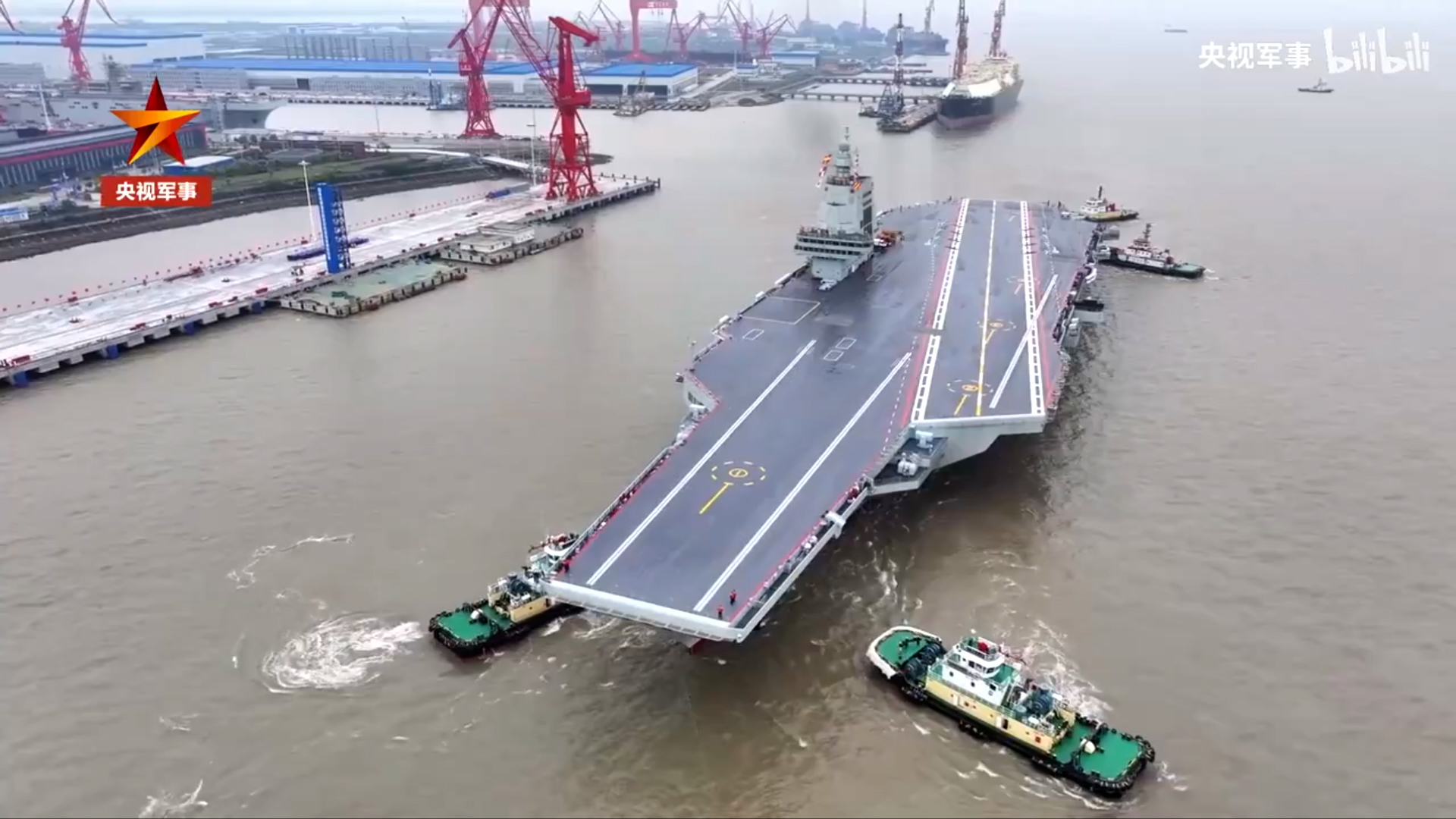
[RYAN ROBERTSON]
IN APRIL SOCIAL MEDIA POSTS OUT OF CHINA POINTED TO A POTENTIAL MAJOR STEP FOR THE CHINESE PEOPLE’S LIBERATION ARMY NAVY. IF THESE IMAGES ARE ACCURATE, THEIR NEWEST AIRCRAFT CARRIER IS SET TO BEGIN SEA TRIALS–
PUTTING THE FUJIAN CLOSER TO OPERATIONAL STATUS.
IT’S A DEVELOP-MENT THAT NO DOUBT HAS THE ATTENTION OF AMERICAN MILITARY LEADERSHIP. NOT ONLY BECAUSE OF THE GROWING THREAT FROM CHINA, BUT THE U.S’s CURRENT SHORTCOMMINGS WHEN IT COMES TO ITS OWN MARITIME FORCES.
IN FEBRUARY RETIRED MARINE CORPS MAJOR JEFFERY SEAVY WROTE A PIECE FOR THE U.S. NAVAL INSTITUTE TITLED ‘T ’. THE CENTRAL THEME OF THE ARTICLE WAS THIS LINE:
”The United States does not have the shipyard capacity to build new ships and fully maintain or repair ships it currently holds in inventory. Given current shipyard capacity, the Navy is estimated to be 20 years behind in maintenance work.”
IT’S A SUBJECT THAT RECEIVED CONSIDERABLE ATTENTION AT THIS YEAR’S ‘SEA AIR. SPACE 2024’ SYMPOSIUM.
{Vice Admiral Frank Morley, Principal Military Deputy to the Assistant Secretary of the Navy}
“Shipbuilding is a key challenge for this decade. It’s really our generational challenge for those of us now in this business to set the stage. And this is a pretty daunting task that the vector is pretty clear.”
[RYAN ROBERTSON]
BUT IT’S NOT JUST MILITARY LEADERSHIP THAT IS SOUNDING A CAUSE FOR CONCERN. IT’S AN ISSUE THEIR COMMERCIAL PARTNERS ARE ALL TOO FAMILIAR WITH.
{George Whittier, CEO Fairbanks Morse Defense}
“If we look at the world today, with the what the situation is in the Red Sea with the Houthi rebels, a potential conflict and the Pacific, obviously, what’s going on in Ukraine with Russia, there’s significant risks that are in the in the world today.”
[RYAN ROBERTSON]
NAVAL DEFENSE SUPPLIER, FAIRBANKS MORSE DEFENSE, STARTED WORKING WITH THE NAVY MORE THAN A CENTURY AGO. AND WHILE THAT RELATIONSHIP REMAINS HEALTHY, C-E-O GEORGE WHITTIER SAYS GETTING THE GOVERNMENT, AND THEIR CIVILIAN PARTNERS, ON THE SAME PAGE IS THE FIRST STEP IN SOLVING THE COUNTRY’S CURRENT SHIPBUILDING DEFICIENCIES.
{George Whittier, CEO Fairbanks Morse Defense}
“The challenge, I think that we’re facing as an industry is that the demand signals coming and the budgetary process are not matching the rhetoric and dialogue and discussion that’s out there. And so as an industry, we need to say, what are the things we can do to try to get increased demand that’s out there to provide more commonality for us for the future?”
[RYAN ROBERTSON]
ACCORDING TO STATISTICS FROM THE UNITED NATIONS, THE U-S AND CHINA ARE ON EQUAL FOOTING WHEN IT COMES TO ECONOMIC OUTPUT. WHERE THE U-S IS FALLING SHORT IS SHIPBUILDING. AND NOT JUST TO CHINA, BUT SOUTH KOREA AND JAPAN AS WELL.
{Vice Admiral Frank Morley, Principal Military Deputy to the Assistant Secretary of the Navy}
“There is no single smoking gun or easy fix to any of this. But it’s all a part of transparent, ruthless pursuit of improving performance. They’re in a measured, very measured fact based data way.”
[RYAN ROBERTSON]
SO WHAT’S THE SOLUTION? ACCORDING TO WHITTIER, PART OF THE ANSWER CAN BE FOUND AWAY FROM THE COASTS.
{George Whittier, CEO Fairbanks Morse Defense}
“The biggest labor constraints are at the shipyards themselves, and the reason for that is they tend to be the dominant employer in their area. And that makes a lot of sense. However, if you think about the Midwest of the US where we operate, we again I have about 1500 employees, we are not labor constrained. And there is a tremendous opportunity to take work out of the shipyards and bring that into the Midwest, and start to get more work done. ”
[RYAN ROBERTSON]
IT’S AN IDEA THAT CARRIES SOME HISTORICAL WEIGHT. A MAJOR PART OF AMERICA’S EXPANSION WESTWARD WAS A 2,300 MILE NATURAL RESOURCE THAT STILL EXISTS TODAY.
{George Whittier, CEO Fairbanks Morse Defense}
“I don’t think we’re utilizing the Mississippi River at all. The Mississippi River is a gem, and we’re just not using it. I mean, St. Louis is one of the biggest cities in the country. And there’s doing no work for the Navy. I mean, it’s right there. Right. There’s labor available in the Midwest. We just have to be smarter about how we apply it.
[RYAN ROBERTSON]
AND JUST AS IMPORTANT AS THE HOW, IS THE WHEN. BECAUSE IF THE TIME COMES, AMERICA LIKELY CAN’T AFFORD TO NOT BE ON THE STARTING LINE WHEN THE GUN SOUNDS.











